
The Tiara of Saitaferne (also Saitaphernes [1] or Saitapharnes) is a tiara in gold sheet, acquired by the Louvre in 1896, afterwards demonstrated to be fake by its creator, Israel Rouchomovsky.

The Tiara of Saitaferne (also Saitaphernes [1] or Saitapharnes) is a tiara in gold sheet, acquired by the Louvre in 1896, afterwards demonstrated to be fake by its creator, Israel Rouchomovsky.
On April 1, 1896, [1] the Louvre announced that it had purchased a gold tiara that had belonged to the Scythian king Saitapharnes. The museum had purchased the artifact for 200,000 gold French francs. A Greek inscription on the tiara read "The council and citizens of Olbia honor the great and invincible King Saitapharnes". To the experts at the Louvre, the tiara confirmed an episode dating to the late 3rd-century BCE or early 2nd-century BCE. According to the story, Saitapharnes had besieged the Greek colony of Olbia and was convinced to leave the city in peace only through the offering of expensive gifts.
Shortly after the Louvre exhibited the tiara, a number of experts challenged its authenticity. Among them was the German archaeologist Adolf Furtwängler [1] who noted many stylistic problems with the tiara's design and questioned the lack of aging apparent on the artifact. For several years, the Louvre defended the authenticity of its treasure and even prepared a magnificent book on the treasure. Eventually, news of the story reached Odesa.
In 1894, two years before the Louvre acquisition, two dealers, Schapschelle Hochmann and his brother Leiba, had commissioned Israel Rouchomovsky (fr), a skilled goldsmith from Odesa, to make the tiara. They let him believe that it was intended as a gift for an archaeologist friend and provided Rouchomovsky with details from recent excavations to aid his design. It wasn't until news of the Louvre scandal reached him that Rouchomovsky learned of the fate of his creation. He traveled to Paris in 1903 [2] and presented himself as the maker of the tiara. Experts at the museum refused to believe him until he demonstrated the ability to reproduce a portion of the crown. Embarrassed, the museum hid the object away in storage. The Louvre had been fooled in one of the greatest archeological scandals of the century; Rouchomovsky, on the other hand, became famous for his work and earned a gold medal at the Paris Salon of Decorative Arts. He lived in Paris until his death in 1934.
In 1954, the tiara was included in a "Salon of Fakes" at the Louvre. [1] In 1997, the Israel Museum in Jerusalem borrowed the Tiara of Saitapharnes from the Louvre for an exhibition on Israel Rouchomovsky. [1] In 2009, the High Museum of Art in Atlanta borrowed the tiara for a Louvre exhibition. In 2014, a memorial plaque was unveiled on the wall of Rouchomovsky's workshop in Odesa where the tiara was created.[ citation needed ] The "LWL-Museum für Archäologie" in Herne, Germany borrowed the tiara for the opening weeks of their new exhibition Irrtümer & Fälschungen der Archäologie (English: Errors & Forgeries in Archaeology) in March 2018.
A copy of the tiara is on display in the British Museum. [3] As of 2009, another was on display at the Tel Aviv Museum of Art. [1]

The Iraq Museum is the national museum of Iraq, located in Baghdad. It is sometimes informally called the National Museum of Iraq, a recent phenomenon influenced by other nations' naming of their national museums; The Iraq Museum's name is inspired by the name of the British Museum, however. The Iraq Museum contains precious relics from the Mesopotamian, Abbasid and Persian civilizations. It was looted during and after the 2003 Invasion of Iraq. Despite international efforts, only some of the stolen artifacts have been returned. After being closed for many years while being refurbished, and rarely open for public viewing, the museum was officially reopened in February 2015.

The James Ossuary is a 1st-century limestone box that was used for containing the bones of the dead. An Aramaic inscription meaning "Jacob (James), son of Joseph, brother of Jesus" is cut into one side of the box. The ossuary attracted scholarly attention due to its apparent association with the Christian holy family.
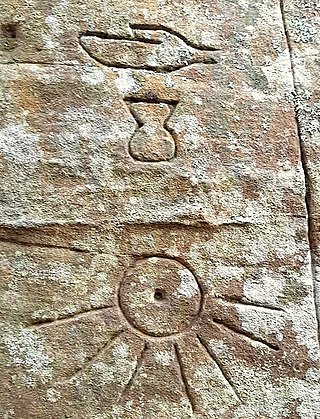
Archaeological forgery is the manufacture of supposedly ancient items that are sold to the antiquities market and may even end up in the collections of museums. It is related to art forgery.
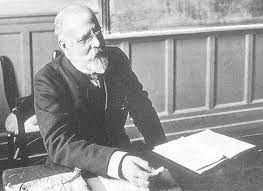
Charles Simon Clermont-Ganneau was a noted French Orientalist and archaeologist.
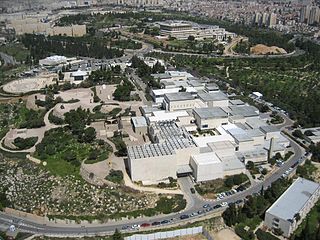
The Israel Museum is an art and archaeological museum in Jerusalem. It was established in 1965 as Israel's largest and foremost cultural institution, and one of the world's leading encyclopaedic museums. It is situated on a hill in the Givat Ram neighborhood of Jerusalem, adjacent to the Bible Lands Museum, the Knesset, the Israeli Supreme Court, and the Hebrew University of Jerusalem.
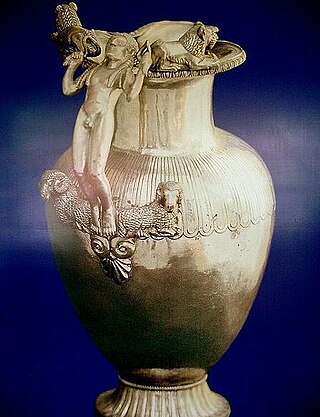
Karu Treasure is the name given to a collection of 363 valuable Lydian artifacts dating from the 7th century BC and originating from Uşak Province in western Turkey, which were the subject of a legal battle between Turkey and New York Metropolitan Museum of Art between 1987 and 1993, which were returned to Turkey in 1993 after the Museum admitted it had known the objects were stolen when they had purchased them. The collection is alternatively known as the Lydian Hoard. The items are exhibited in the Uşak Museum of Archaeology.

The Ziwiye hoard is a treasure hoard containing gold, silver, and ivory objects, also including a few gold pieces with the shape of human face, that was uncovered on in Ziwiyeh plat near Saqqez city in Kurdistan Province, Iran, in 1947.

The Varna Necropolis, or Varna Cemetery, is a burial site in the western industrial zone of Varna, internationally considered one of the key archaeological sites in world prehistory. The oldest gold treasure and jewelry in the world, dating from 4,600 BC to 4,200 BC, was discovered at the site. Several prehistoric Bulgarian finds are considered no less old – the golden treasures of Hotnitsa, Durankulak, artifacts from the Kurgan settlement of Yunatsite near Pazardzhik, the golden treasure Sakar, as well as beads and gold jewelry found in the Kurgan settlement of Provadia – Solnitsata. However, Varna gold is most often called the oldest since this treasure is the largest and most diverse.

Malagana, also known as the Malagana Treasure is an archaeological site of Colombia named after a sugarcane estate where it was accidentally discovered in 1992. During the few days after its discovery, the place was subject to a large scale looting with a rough estimate of 4 tons of pre-Columbian artifacts illegally removed from the burial mounds. A rescue archaeological mission was sent by the National Institute of Anthropology and History (ICANH), led by archaeologist Marianne Cardale de Schrimpff. Archaeological excavations at the site established a previously unknown cultural complex, designated as Malagana-Sonsoid, that dates between 300 BC to 300 AD.
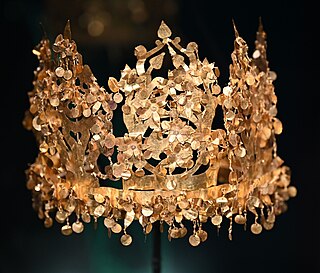
Tillya tepe, Tillia tepe or Tillā tapa is an archaeological site in the northern Afghanistan province of Jowzjan near Sheberghan, excavated in 1978 by a Soviet-Afghan team led by the Soviet archaeologist Viktor Sarianidi. The hoard found there is often known as the Bactrian gold.

The Varna culture was a Chalcolithic culture of northeastern Bulgaria, dated ca. 4500 BC, contemporary and closely related with the Gumelnița culture. The oldest golden artifacts in the world are found in the Necropolis of Varna - grave offerings on exposition in Varna Archaeological Museum

The Oxus treasure is a collection of about 180 surviving pieces of metalwork in gold and silver, most relatively small, and around 200 coins, from the Achaemenid Persian period which were found by the Oxus river about 1877–1880. The exact place and date of the find remain unclear, but is often proposed as being near Kobadiyan. It is likely that many other pieces from the hoard were melted down for bullion; early reports suggest there were originally some 1500 coins, and mention types of metalwork that are not among the surviving pieces. The metalwork is believed to date from the sixth to fourth centuries BC, but the coins show a greater range, with some of those believed to belong to the treasure coming from around 200 BC. The most likely origin for the treasure is that it belonged to a temple, where votive offerings were deposited over a long period. How it came to be deposited is unknown.

The Quimbaya (/kɪmbaɪa/) were a small indigenous group in present-day Colombia noted for their gold work characterized by technical accuracy and detailed designs. The majority of the gold work is made in tumbaga alloy, with 30% copper, which colours the pieces.
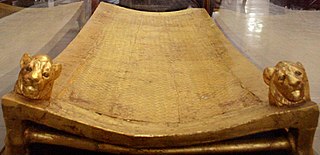
Exhibitions of artifacts from the tomb of Tutankhamun have been held at museums in several countries, notably the United Kingdom, Soviet Union, United States, Canada, Japan, and France.

Việt Khê is an archaeological site in the Red River Delta in northern Vietnam. Excavations there yielded a number of coffins containing relics of the Dong Son culture in Bronze Age. The Việt Khê construction site is located on the southern base of a hill which overlooks the Hàn River near Thủy Nguyên District, Haiphong. Five wooden coffins were excavated in 1961, each of which were aligned in the east-west direction, with at least two pairs of coffins being configured in a linear manner.
Dietrich Felix von Bothmer was a German-born American art historian, who spent six decades as a curator at the Metropolitan Museum of Art, where he developed into the world's leading specialist in the field of ancient Greek vases.

The ivory pomegranate is a thumb-sized semitic ornamental artifact acquired by the Israel Museum. It is not actually made of ivory, but of hippopotamus bone and bears an inscription; Holy (Sacred) to the Priest of the House of God (YHWH).

The Fabergé Museum is a privately owned museum located in the German spa city of Baden-Baden, dedicated to items made by the Russian jewellery firm Fabergé. It was opened by Russian art collector Alexander Ivanov on 9 May 2009. It is owned by the private limited company Fabergé Museum GmbH, which was originally co-founded by Alexander Ivanov and Konstantin Goloshchapov in January 2008.

The Odesa Archaeological Museum is one of the oldest archaeological museums in Ukraine. It was founded in 1825; the current museum building was completed in 1883 according to a design by Polish architect Feliks Gąsiorowski.

Several kinds of archaeological remnants of the Jerusalem Temple exist. Those for what is customarily called Solomon's Temple are indirect and some are challenged. There is extensive physical evidence for the temple called the Second Temple that was built by returning exiles around 516 BCE and stood until its destruction by Rome in the year 70 CE. There is limited physical evidence of Solomon's Temple, although it is still widely accepted to have existed.